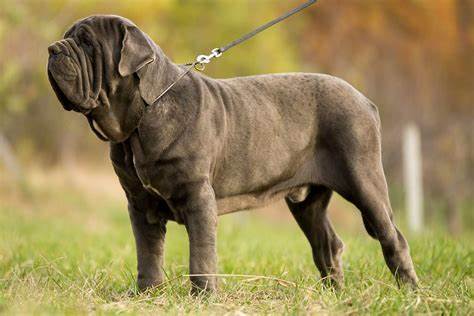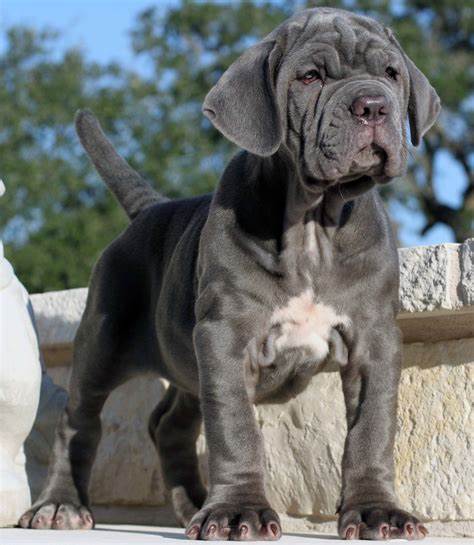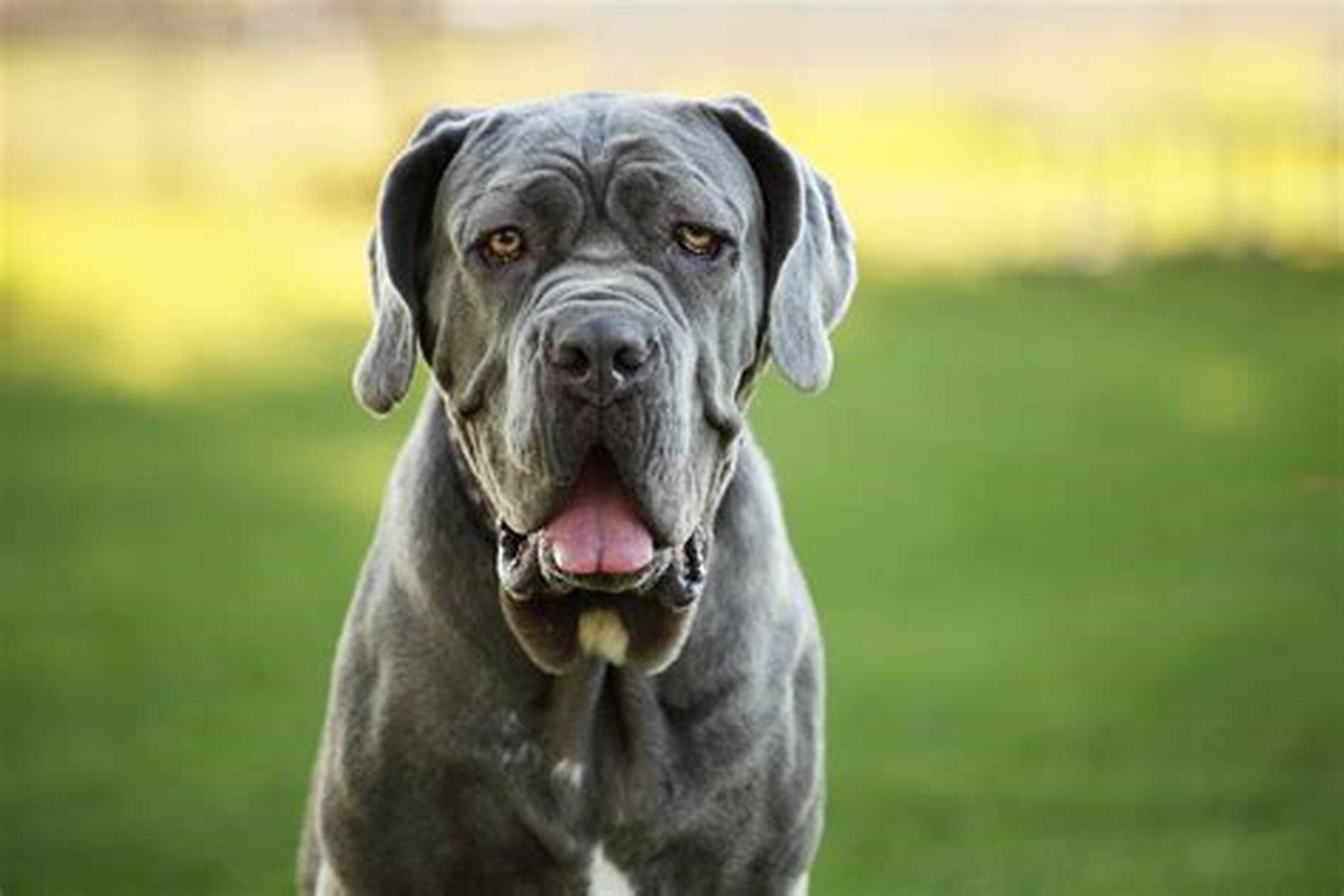
The Neapolitan Mastiff, or "Mastino Napoletano," is a powerful and ancient breed with roots that trace back to the Roman Empire. These dogs are believed to have descended from the Molossus, a war dog used by the Romans, Greeks, and other ancient civilizations for guarding and combat. Over time, the breed evolved in Southern Italy, particularly around Naples, where it was selectively bred for guarding estates and property.
Historically, the Neapolitan Mastiff was bred not for appearance but for function—massive size, strength, and a naturally protective instinct. The breed remained largely hidden from the world until the 20th century when it was rediscovered and standardized by Italian breeders. It gained international recognition in the mid-1900s and was officially accepted by the American Kennel Club in 2004.
While not one of the most common breeds, the Neapolitan Mastiff is admired for its imposing looks and loyal temperament. Its popularity is strongest among experienced dog owners who value its guardian instincts, calm demeanor, and unmistakable appearance. The breed is especially revered in Italy and has slowly gained fans in the United States and Europe due to its unique presence.
The Neapolitan Mastiff is a giant breed with a commanding presence. Its most notable features are its massive head, loose, heavily wrinkled skin, and lumbering gait.
Coat:
Short, dense, and smooth. Weather-resistant and easy to maintain.
Color:
Typically comes in blue, black, mahogany, and tawny. Some have brindling or small white markings on the chest and toes.
Size:
• Height: 24–31 inches (61–79 cm)
• Weight: 110–150+ lbs (50–70+ kg)
Head & Expression:
Huge and broad with a pronounced stop and deeply wrinkled face. The droopy eyelids and lips contribute to a distinctive, somber expression.
Body:
Heavily boned, muscular, and rectangular in shape. Strong neck and chest, broad back, and thick legs.
Tail:
Thick at the base and tapers to a point, carried low with a slight curve.
The Neapolitan Mastiff is a calm, steady, and protective dog. Despite its intimidating appearance, it is known to be a gentle giant with its family.
Loyal and Protective:
Bred to guard, the Neapolitan Mastiff is naturally wary of strangers and very devoted to its people.
Quiet Guardian:
This breed rarely barks unnecessarily. It prefers to observe and step in only when it perceives a real threat.
Affectionate with Family:
They are loving and gentle with those they know, especially children, though supervision is advised due to their size.
Low Energy Indoors:
Neapolitan Mastiffs are not overly energetic, making them manageable in the home if their exercise needs are met.
Independent:
While trainable, the breed has an independent streak and can be stubborn. Early and consistent training is crucial.
Not for Novices:
This breed is best suited for experienced dog owners who understand large guardian breeds.

Natural Guard Dog:
No need for additional training—this breed instinctively protects home and family.
Impressive Presence:
For those who want a dog that turns heads, few breeds compare to the Neapolitan Mastiff’s massive build and wrinkled face.
Loving Companion:
With the right socialization, these dogs are affectionate with family and loyal to the core.
Quiet and Calm Indoors:
Though large, they are not hyperactive and can be quite relaxed at home.
Minimal Grooming:
The short coat requires only occasional brushing, although skin folds must be cleaned to avoid infections.
Training:
Begin socialization and training early. Positive reinforcement and firm, patient leadership are key. Avoid harsh corrections.
Exercise:
Moderate exercise is ideal. Daily walks and play in a secure area suffice. Avoid overexertion in puppies to protect growing joints.
Grooming:
Brush weekly. Clean skin folds regularly to prevent bacterial buildup. Keep ears clean and nails trimmed.
Diet:
Feed a high-quality diet tailored to large breeds. Weight management is important to avoid stress on joints.
Living Conditions:
Due to their size and guarding nature, Neapolitan Mastiffs are best in homes with space and a secure yard. They do not do well in apartments.

The Neapolitan Mastiff is a large, heavy-boned breed and is susceptible to certain health issues. Lifespan ranges between 7–9 years.
Common Concerns:
• Hip and elbow dysplasia
• Cherry eye
• Bloat (gastric torsion)
• Skin infections (particularly in folds)
• Heart problems
Regular veterinary care and maintaining a healthy weight can help manage many of these concerns.
Compared to the English Mastiff, the Neapolitan Mastiff is more aloof and protective. It has a more rugged appearance and a stronger guarding instinct. The English Mastiff is typically more laid-back and people-friendly.
When compared to the Cane Corso, another Italian guardian breed, the Neapolitan Mastiff is bulkier and less agile. The Cane Corso is more athletic and often preferred for activities requiring speed and agility, while the Neapolitan Mastiff excels in sheer presence and defense.
This breed is best for owners who:
• Have experience with large, powerful dogs
• Want a calm, low-energy guardian
• Can invest time in training and socialization
• Have space for a large dog
• Can handle drool and frequent skin maintenance
Not Ideal For:
• First-time dog owners
• Apartment living
• Those seeking a high-energy or playful dog
• People unwilling to manage drool or large dog care
United Pet Club can help connect you with resources to care for your Neapolitan Mastiff. Whether you're looking for breeders, trainers, or health advice, we’re here to ensure your giant guardian thrives in their forever home.